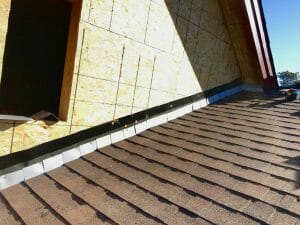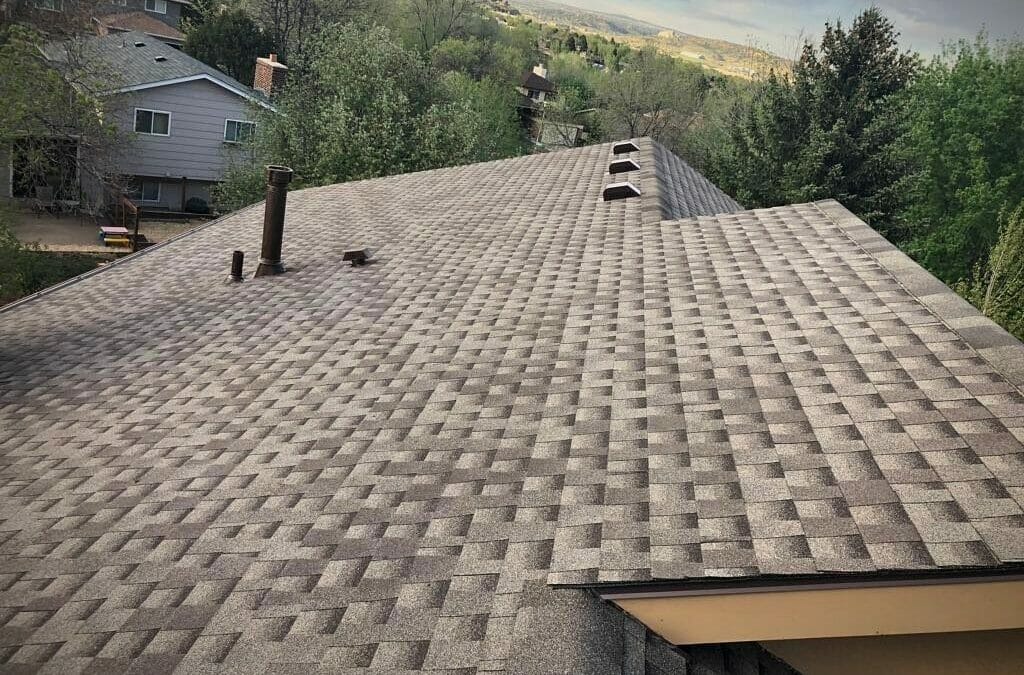In the state of Colorado, wood shingles and shakes are being removed and in place of wood shingles and wood shakes asphalt shingles are being installed. Because of the prevailing risk of wild fires in Colorado many building departments no longer allow for the installation of wood shingles and shakes. In the interest of the community, the same is true for many other states have outlawed wood roofs. Wood shakes and shingles pose a significant risk to not only the homeowner, but to the surrounding community. Let’s take a look at several items that Denver roofers should take into consideration before replacing your wood roof.
Wall to roof flashing
Before the roof replacement begins the Denver roofing company should inspect the existing wall to roof flashing to make sure that it can be re-used with asphalt shingles. The condition of the metal flashing must be like new and without rust, cracks, or an abundance of nail holes.
Step flashing

Step flashing along wall of new construction
The old 4×5 flashing along the wall should be replaced with new step flashing to match the new asphalt shingle. Premium heavy weight shingles may be 16” in overall height as opposed to the traditional height of 12”. The taller shingle should be accompanied by a larger piece of step flashing. Discuss these items with your roofer to make sure that the step flashing properly sheds water from one shingle to the next.
Headwall flashing
The headwall flashing is installed along the face of a wall abutment that is parallel with the eave. This is an item that me be worth recycling. In order to replace headwall flashing on wall that has wood, metal or vinyl siding the siding will have to be removed. A minimum of one course of siding will need to be removed in order to insert a pre-bent sheet of galvanized flashing for the headwall. What this means to a homeowner for a wall with wood siding is the wall or a portion of the wall should be painted. The pre-existing siding that was removed will now be re-attached. The new nail holes should be puttied and the siding caulked, as necessary. Once the siding is reinstalled this piece of siding should be repainted.
There is a potential issue if the door doesn’t match. The truth is even if you have the same paint in a can that was left over from the most recent paint job you may find that it doesn’t match because the house paint has faded from the suns ultraviolet rays. This isn’t anyones fault it’s what paint will do over time. Let’s take at the painting issue a little further to see what else may impact your homes exterior paint job when transitioning from a wood roof to an asphalt shingle.
Exterior painting
Unless the exterior painting is part of the Denver roofing companies scope of work this will be an item that you should be a part of the roofing budget. The roofing contractor may mention to you or at least note this in the contract that you’re responsible for any cosmetic issues to the siding or wood trim. The roofing contractor may be willing to provide a painter for the repairs at a material plus labor pricing or a set price to not exceed a pre-determined amount. Either way this isn’t the responsibility of a roofer. If the roofing company chooses to prepare you for this and to provide a painter they are going the extra mile. Integrity Roofing and Painting, LLC typically brings this information to the attention of everyone, especially if we know the exterior paint will be impacted. However, there are times when we say nothing because we’re reasonably confident that the painting will not be impacted because we’re planning on re-using the existing flashing.
Rotted wood
While installing flashing the roofing contractor may encounter existing wood siding or trim along the roof to wall intersection that is deteriorated or “dry rotted”. This condition is not a result of the roofer and it is pre-existing, however a homeowner may argue that it wasn’t that way before the new asphalt shingles were installed. This statement would not be accurate for the rotted wood was present and it was revealed when the flashing was replaced. This is not the financial responsibility of the roofer to replace rotted wood. This is a maintenance issue that is the financial responsibility of the homeowner. If the Denver roofing company chose to not replace the flashing because of a homeowner’s lack of maintenance than you’re issues would be compounded. The roofer has done a homeowner a favor by locating the rotted wood. You should pay for this expense and the Denver roofer may or not have someone that can help for this is a carpentry issue and not a roofing issue.
Gap between the new shingles and bottom of the siding
Another item of interests to a homeowner when replacing a wood shake roof with an asphalt shingle is the thickness of these two differing products. A wood shake may be thicker than one inch while a heavy weight asphalt shingle may be 1/4” thick and a lightweight asphalt shingle may only be 1/8” thick. The result may be approximately 1” difference of height between these products and they may not seem like a lot, but you’ll notice the difference where a sloping roof meets a wall. At this intersection you’ll see a 1” or greater gap from the bottom of the siding to the top of the shingle. In some cases we’ve seen a 2” gap and at this location metal flashing is visible and it may be unsightly. If the old flashing is being salvaged you may choose to hire a painter to paint this flashing with a color that will help camouflage the metal. This is not the responsibility of the Denver roofing company. If the roofer mentions this to you before the roof is replaced he has gone the extra mile.
How to flash stucco or brick
The roofing contractor may need to apply new flashing on top of stucco or brick. This type of flashing is called, “counter flashing.” At this point if the old flashing can be recycled it would be advantageous for the homeowner and roofer alike to re-use the older metal. Counter-flashing is unattractive and certainly detracts from the home’s appearance. However, the roofer may have to install counter flashing in conjunction with new head wall or step flashing. This may be an additional charge that is fair and reasonable. The older a property is the more likely that this will occur.
New decking may be needed
There are wood shingle and shake roofs that are installed on top of wood laths. These 1×4 or 1×6 boards are spaced several inches apart and will require new decking to be installed on top of them. At other times we find wood planks that have gaps larger than 1/4 “ and these too should have new decking installed on top of the older planks. Most contractors will discover this before removing the wood shakes, but occasionally surprises do occur, especially on older homes that have been remodeled. We’ve been surprised a few times on homes that had additional rooms added after the original construction and the contractor used different construction methods. When one the Denver roofers encounters this it should not be the roofers liability, it would be the homeowner’s financial responsibility to pay for things that are uncovered and hidden. This is rare, but it does happen in Colorado Springs or Denver on homes that are older, especially homes that were built before the 1940’s.
Roof ventilation
Homeowner’s should fund the addition of new roof ventilation when the roof is transitioned from wood to asphalt.
Integrity Roofing and Painting, LLC has the highest level of certification of all the Denver Roofers. We are one of the few and proud that have been certified by Certainteed as a Master Shingle Roofing Company. Please contact us for your roof replacement. We make roof replacements easy!

